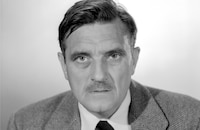Considering the premise, it's easy to understand why Red Planet Mars received mixed reactions from the critics, ranging from complete bafflement to outright hostility, but the film has been noted for some of its eerily prophetic plot points: The U.S. president in the film, played by Willis Bouchey, bears a resemblance to Dwight D. Eisenhower, the former chief of staff of the U.S. Army, who officially took office as the president in 1953. There are also physical similarities between the Russian priest who overthrows the communist government in the Soviet Union and the Ayatollah Khomeini, who rose to power in Iran during the fifties.
In comparison to other sci-fi thrillers of the fifties, Red Planet Mars offered no alien mutants or ray-gun battles and was certainly a disappointment to any kid expecting some cheap thrills at a Saturday matinee. On the other hand, the film should prove endlessly fascinating to anyone interested in fifties culture in America. The dialogue alone is a crash course in social attitudes of the era, some of it blatantly sexist, as in the scene where Cronyn contemplates his unscientific wife - "Poor Linda, with all her silly fears." And there are plenty of other howlers in the script, not to mention the occasionally hilarious integration of stock footage into the narrative and some overwrought performances.
The talents behind this oddball effort are not your usual suspects in the B-movie industry. For instance, producer/screenwriter Anthony Veiller worked with some of Hollywood's most gifted directors like Frank Capra (State of the Union, 1948) and John Huston (Moulin Rouge, 1952). Charles D. Hall was a set designer who worked on such key Universal horror thrillers as Dracula (1931) and The Bride of Frankenstein (1935). Co-scripter John D. Balderston also wrote the screenplay for the latter film as well as other fantastic flicks like The Mummy (1932). Director Harry Horner was best known for his Oscar-winning work as an art director on The Heiress (1949) and The Hustler (1961), and Peter Graves went on to star in the cult TV series Mission: Impossible.
Producer: Donald Hyde, Anthony Veiller
Director: Harry Horner
Screenplay: John Hoare (I) (play), John L. Balderston (play), Anthony Veiller
Art Direction: Charles D. Hall
Cinematography: Joseph F. Biroc
Film Editing: Francis D. Lyon
Original Music: Mahlon Merrick
Principal Cast: Peter Graves (Chris Cronyn), Andrea King (Linda Cronyn), Walter Sande (Adm. Carey), Orley Lindgren (Steward Cronyn), Marvin Miller (Arjenian), Herbert Berghof (Franz Calder).
BW-88m.
by Jeff Stafford





















